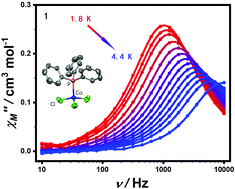Recently, the choice of ligand and geometric control of mononuclear complexes, which can affect the relaxation pathways and blocking temperature, have received wide attention in the field of single-ion magnets (SIMs). To find out the influence of the coordination environment on SIMs, two four-coordinate mononuclear Co(II) complexes [NEt4][Co(PPh3)X3] (X = Cl−, 1; Br−, 2) have been synthesized and studied by X-ray single crystallography, magnetic measurements, high-frequency and -field EPR (HF-EPR) spectroscopy and theoretical calculations. Both complexes are in a cubic space group Pa![[3 with combining macron]](http://www.rsc.org/images/entities/char_0033_0304.gif) (No. 205), containing a slightly distorted tetrahedral moiety with crystallographically imposed C3v symmetry through the [Co(PPh3)X3]− anion. The direct-current (dc) magnetic data and HF-EPR spectroscopy indicated the anisotropic S = 3/2 spin ground states of the Co(II) ions with the easy-plane anisotropy for 1 and 2. Ab initio calculations were performed to confirm the positive magnetic anisotropies of 1 and 2. Frequency- and temperature-dependent alternating-current (ac) magnetic susceptibility measurements revealed slow magnetic relaxation for 1 and 2 at an applied dc field. Finally, the magnetic properties of 1 and 2 were compared to those of other Co(II) complexes with a [CoAB3] moiety.
(No. 205), containing a slightly distorted tetrahedral moiety with crystallographically imposed C3v symmetry through the [Co(PPh3)X3]− anion. The direct-current (dc) magnetic data and HF-EPR spectroscopy indicated the anisotropic S = 3/2 spin ground states of the Co(II) ions with the easy-plane anisotropy for 1 and 2. Ab initio calculations were performed to confirm the positive magnetic anisotropies of 1 and 2. Frequency- and temperature-dependent alternating-current (ac) magnetic susceptibility measurements revealed slow magnetic relaxation for 1 and 2 at an applied dc field. Finally, the magnetic properties of 1 and 2 were compared to those of other Co(II) complexes with a [CoAB3] moiety.

